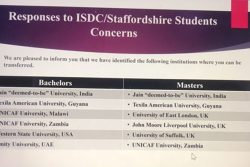The current situation is not sustainable. That was the stark warning yesterday by the Chairman of the National Insurance Scheme, Dr Roger Luncheon, that major changes would have to be made to the social security system.
It follows a string of warnings by commentators and politicians that the government has ignored the deepening plight of the NIS, particularly over the last decade.
Luncheon said that the 44th anniversary of the National Insurance Scheme cannot be viewed without “mixed concerns by the different categories of stakeholders and decision-makers.”

He added “even though the spectre of an imminent dire situation is highly exaggerated, the Scheme’s financial viability does evoke apprehension among the informed.”
He then pointed out as others have done for a number of years that the Scheme’s expenditure growth is exceeding revenue growth.
Contribution income was G$11.32B in 2012 while benefits expenditure, the main item of expenditure was G$11.33B.
He pointed out that long term benefits dominate the benefits liability with over 43,000 pensioners in payment at July, 2013.
Luncheon acknowledged that efforts to get the self-employed enrolled have produced negligible results.
He said that at the end of 2012, the active population of the employed contributors totalled 117,219 while the active population of the self-employed was only 8,791.
“The self-employed situation of anomaly is evident in the face of the size of parallel economy in Guyana,” Luncheon said in his message to mark the 44th anniversary of the Scheme.
In the meanwhile, he said the NIS continues to offer a pension indexed to minimum wages in the public service with a wide range of benefits to contributors and pensioners.
The end result is that expenditure growth exceeds that of revenue. The NIS fund is therefore being used to meet the deficits currently being registered.
As a result, he said the NIS fund has failed to show growth over the recent years.
Luncheon pointed out that the 8th actuarial report on the Scheme’s financial status made concrete proposals/recommendations about solutions and that nationwide public consultations at the time evinced concern among stakeholders.
“A general principled approach must include increased revenue collection and controlled expenditure growth,” Luncheon contended.
He pointed out that in the 2013 national budget, the Minister of Finance, proposed an increase in the contribution rate for both employed and self-employed to 14% and 12.5% respectively but this did not significantly reverse the deficit.
“While as stated before there is little likelihood of a collapse of the Scheme in the short to medium term, the current situation is not sustainable.
“The interventions are obvious but consensus among stakeholders and decision-makers is a paramount necessity,” Luncheon asserted.
A similar situation in Barbados attracted such consensus on the way forward, Luncheon said.
He said that a parallel in Guyana must provide for a long term solution that revolves around two main thrusts.
1. Significant expansion in the population of contributors and increased contribution rates.
2. Managed growth in benefit expenditure particularly pensions.
In the 8th actuarial report, the reviewer, Mr Derek Osborne of Horizonow was blunt in his assessment, declaring that the Scheme was nearing a crisis and immediate steps were required to pull it back from the brink, including raising the contribution rate from 13% to 15% no later than January next year, hiking the wage ceiling to $200,000 per month, freezing pension increases and raising in a phased manner the pensionable age from 60 to 65.
A raft of other measures was enunciated in the report which in a matter-of-fact manner set out the jeopardy faced by the Scheme and other dangers such as an unbalanced investment portfolio and a low number of contributors. Osborne also raised doubts about the quality of governance at the NIS and the efficiency of the Scheme.








